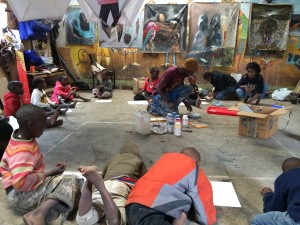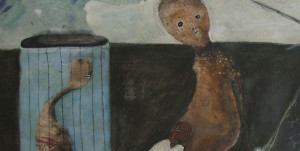
For both John Kamicha and Shabu Mwangi art is their way of reaching out to their fellow Kenyans and challenging them to reflect on the contradictions and opportunities of modern life in Nairobi. John Kamicha: “That’s what art is about for me: questioning things, not about adopting a style and selling beautiful images of wild animals to tourists, hotels and expats. I want to wake people up. Why keep quiet and pretend and act ignorantly? ”
Rosalie van Deursen on Kenyan artists John Kamicha and Shabu Mwangi.
Shuba Mwangi, My Dream.
AGAINST THE STREAM
Kenyan artists John Kamicha & Shabu Mwangi
Kenyan art is often associated with beautiful landscapes, wild animals and stately Masaai warriors. But for the younger generation of conceptual artists, this ‘commercial art’ is uninspiring. What drives them is expressing the complexities of modern life in mega-cities such as Nairobi. Nairobi is a dynamic metropolis, with fast bucks and construction sites, winners and losers and this contradictory mix forms a rich breeding ground for their creative minds.
Both John Kamicha and Shabu Mwangi are engaged and taboo-breaking artists based in Nairobi. They are unafraid about confronting contradictions in modern Kenyan life and express a deep faith in art as a platform for freedom of expression. Shabu Mwangi focuses on the dangers and challenges of living in Nairobi’s Lungalunga slum where he was born and raised. John Kamicha addresses the heady mix of religion, capitalism and corruption.
Breaking taboos – John Kamicha
 John Kamicha showing newspaper.
John Kamicha showing newspaper.
“I don’t like people who agree with me!” Discussing, questioning and experimenting with materials, techniques and content are second nature to John Kamicha. He loves to focus on taboos but the strong messages that he expresses often get him into trouble. John explains: “When my work is related to prostitution, homosexuality or religion, people get mad at me. But I want to do research about what happens in Kenyan society.”
Questioning God
During his twenties, John was a Rastafarian. He read the bible many times; a chapter a day for seven years in a row. The more he read the more he started questioning Christianity. “I questioned everything and had more and more doubts about religion. I didn’t feel there was a God. I tried kneeling down and praying but it didn’t make sense to me anymore! So I decided to give God a break and stopped believing.” John started to think about Jesus as a human being and what kind of life he had lived as a man. He became fascinated and wanted to explore this phenomenon in his art.
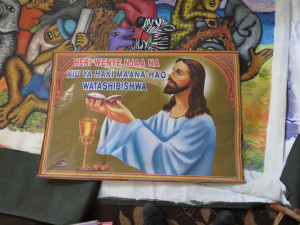 Jesus with lipstick
Jesus with lipstick
Jesus with lipstick
As a reaction to people worshipping images of Jesus and the Virgin Mary, John started to make collages of posters that he bought from street vendors. For example, he used Leonardo da Vinci’s painting ‘The Last Supper’ as a basis for a collage. John: “Nobody questions the image itself! Leonardo just came up with an image of Jesus and now everyone is copying this and believes this is what Jesus looked like. But… why does he have lipstick? Why did he choose to have twelve men as disciples? Maybe Jesus was gay! Or maybe he had just kissed a woman or drunken red wine. It’s my own fantasy, not that I am trying to tell the truth, but people should be open and discuss these things! Nobody has copyright on the bible!”
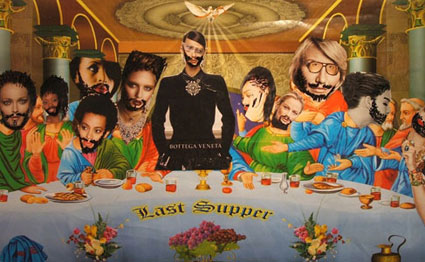 Last Supper.
Last Supper.
In his ‘Last Supper’ collage John turns Jesus into a gay celebrity surrounded by other celebrities. He depicts Jesus and the Virgin Mary in explicit sexual circumstances and uses unambiguous titles such as ‘Sex Retreat’, ‘You are the man I want’ and ‘the Nun’. The series of collages were exhibited in an exhibition called ‘Sex and the City’ at Alliance Française in Nairobi. John got into a lot of trouble and he was accused of blasphemy. John: “I never saw it coming. I was so much into exploring and doing research that I even forgot that other people believe in other things. If you really believe that something is the truth, then why should you be afraid to question it? If God is really the master he should not be afraid of questions. I don’t care how other people live their life and what they want to believe… at least I spoke my mind.”

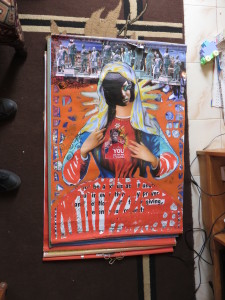 The Nun (left). Youare the man I want (right).
The Nun (left). Youare the man I want (right).
Hooked to prostitutes
After all the fuss John realised he was far from conventional or mainstream and was inspired to explore what he perceives as hypocrisy in Kenyan society even further. He made a series of collages with prostitutes and policemen in which he wants to show the strength hookers have but also the fact that they are demonized. John: “It’s unbelievable how much power these street women have. Powerful politicians and priests all go to hookers. People demonize prostitutes but in secret at night they sneak out and have fun. The next day in church you see them acting all holy… How come we never demonize the men that visit prostitutes?”
Give me your best shot
In his series entitled ‘Give me your best shot’, John addresses the hypocrisy of policemen when they arrest and photograph prostitutes. John: “They want the best shot not because they are really interested in the profile pictures of arrested prostitutes but because they want to play with these beautiful women. They are just enjoying looking at them and even allow them to pay their fine with sexual favours. It’s all very corrupt.” Questioning societal assumptions is an important drive in John’s art.
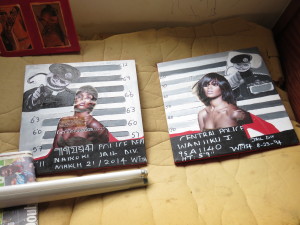 Give me your best shot.
Give me your best shot.
Black is the New White
Johns critique of human behaviour is also visible in his work entitled ‘Black is the New White’. His collage shows a white face but the typical Fulani ethnic hat and beads show the person is clearly black. The comparison is not just about physical appearance but also about behaviour. John explains: “Black people are doing things that they used to accuse colonial people of. Now they are doing it themselves! It’s like modern slavery, for example hiring servants for peanuts and focussing on self-enrichment instead of investing in the community.” He doesn’t want to ‘preach’ but feels like he needs to get his message out into the world, to show different perspectives.
John finds it very sad that the importance of art is underestimated by Kenyans. “Creativity is the future, otherwise people become robots. I call on people to join me in in the debate. Art is reflection, art is life!”
Gangsters as role models – Shabu Mwangi
Shabu Mwangi also wants to open people’s eyes to realities they would prefer to ignore, such as illegal abortions, under-age prostitution and fires in the slums caused by illegal electricity and oil leaks from nearby factories. In other words, the toughness of living in a slum in Nairobi.
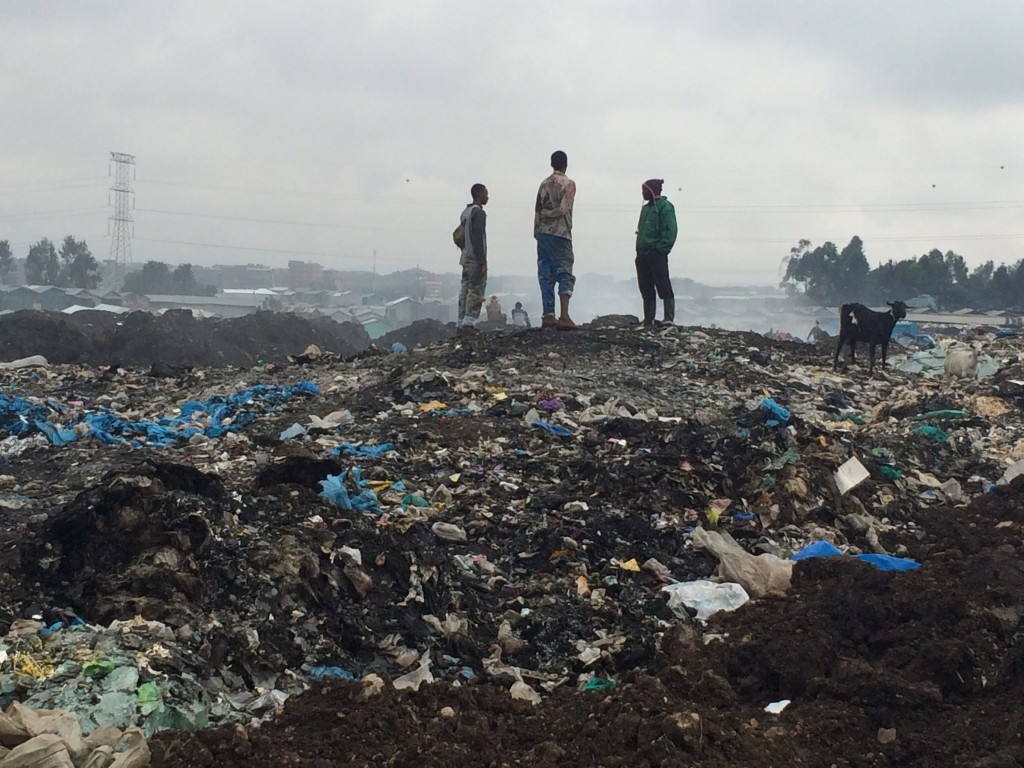
Shabu Mwangi on rubbish dump
Scary events
Shabu’s paintings are about the human emotions he encounters amongst his fellow slum-dwellers. He shows events that nobody else pays any attention to. As he explains: “In this postmodern life people live together but are isolated bubbles and want to show others that they are cool and happy… But people forget that they can only understand happiness if they know what sadness means.” The sadness that Shabu has experienced first-hand during his harsh life in the slums of Nairobi informs much of his art. His paintings are narratives. The dark colours and abstract figures have an alienating effect. “People feel pain when they see my work. It’s about humans and events that happen in the slum. The faces are not scary, but what takes place is scary and I can only embody that through facial expressions.”

Shabu Mwangi, Black Moon
 Shabu Mwangi, Yellow Line
Shabu Mwangi, Yellow Line
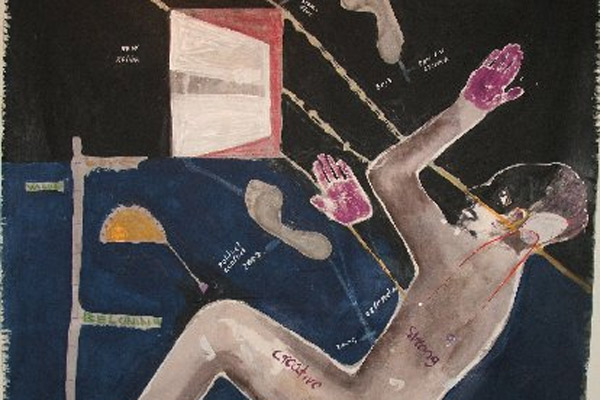 Shabu Mwangi, The Body Map.
Shabu Mwangi, The Body Map.
Growing up next to a rubbish dump
Shabu Mwangi was born in Lungalunga slum in Nairobi where he grew up with his mother and eleven other children in very difficult circumstances. In order to earn money he spent his childhood on the dump collecting iron, plastic and other rubbish to recycle. Shabu‘s generation didn’t have a positive vision for the future: “Our role models were gangsters and it was all about crime. I couldn’t even date a girl from outside Lungalunga slum, because it had such a bad reputation. After I lost all my fellow artists in the crime scene I decided to change my behaviour and now I want to upgrade my slum by motivating the younger generation and give them something I never had: a positive role model.” With his art and art projects in Lungalunga slum Shabu is practicing what he preaches.
Upgrading the slum
Wajukuu Art Centre/Kids Club
Shabu set up ‘Wajukuu Art Centre’ together with his now deceased artist friends. Wajukuu is a Swahili word meaning: grandchildren. It is related to the Swahili concept ‘consequences to the grandchildren’. ‘If you do something wrong, it will affect you now and your kids later.’ Shabu: “It’s why we are in the slums while others are in wealthier places. Our grandparents they might have been lazy or they did something wrong and that’s why we are here. We are facing the consequences of their behaviour and choices.” The Wajukuu group of artists want to change lives in the slum. Shabu: “Instead of gangsters as role models, artists are now role models. Kids might not listen to me, but they are very good at imitating.” That is what art is all about according to Shabu, passing on moral values that make people more aware.
Art as sacrifice
For Shabu, art and being an artist is almost like a religion that provides people with a moral framework. He explains: “It provides freedom and a higher self-esteem, people start longing for something when they connect with art. That’s what I love about being an artist; it gives me the ability to make others feel free. If you want to do something, the universe will support you: just go for it!”
For both John Kamicha and Shabu Mwangi art is their way of reaching out to their fellow Kenyans and challenging them to reflect on the contradictions and opportunities of modern life in Nairobi. John Kamicha: “That’s what art is about for me: questioning things, not about adopting a style and selling beautiful images of wild animals to tourists, hotels and expats. I want to wake people up. Why keep quiet and pretend and act ignorantly? ”
Rosalie van Deursen, Art Historian, www.rosalievandeursen.nl. http://www.urbanafricans.com

